Is it possible to eat watermelon with cholecystitis and pancreatitis?
Therapeutic nutrition for cholecystitis creates normal conditions for the accumulation of bile and its release into the small intestine, and serves as a good prevention of relapses. The main goal of the diet for acute pancreatitis is to stop the production of pancreatic juice, which is achieved by fasting and strict bed rest. Even exposure to the sight and smell of food is undesirable. After the attack subsides and the pain is relieved, the diet is gradually expanded, new foods are included, and the volume of food and its calorie content are increased.
During the remission period, fresh vegetables and fruits are allowed, including watermelon. It is rich in vitamin A, ascorbic acid, lycopene, pectin, calcium, sodium, magnesium and other chemical components necessary to ensure the proper functioning of the digestive system and the body as a whole. However, the fruit is not useful for all diseases.
In the article we will consider whether it is possible to eat watermelon with cholecystitis and pancreatitis, rules and regulations for consumption in the acute/chronic period, contraindications, precautions.
The benefits and harms of watermelon
Watermelon contains a large number of biological substances important for the human body. Vitamin A in recommended doses slows down the aging process, stimulates tissue renewal and growth, nourishes and moisturizes the skin.This is a powerful antioxidant that normalizes metabolism, prevents the formation of cancer cells, regulates the synthesis of hormones, and creates favorable conditions for the full functioning of the immune system.
Lycopene in the fruit pulp performs an antioxidant function and neutralizes dangerous free radicals. With insufficient lycopene content, the risk of developing cardiovascular diseases, prostate, lung, and stomach cancer increases.
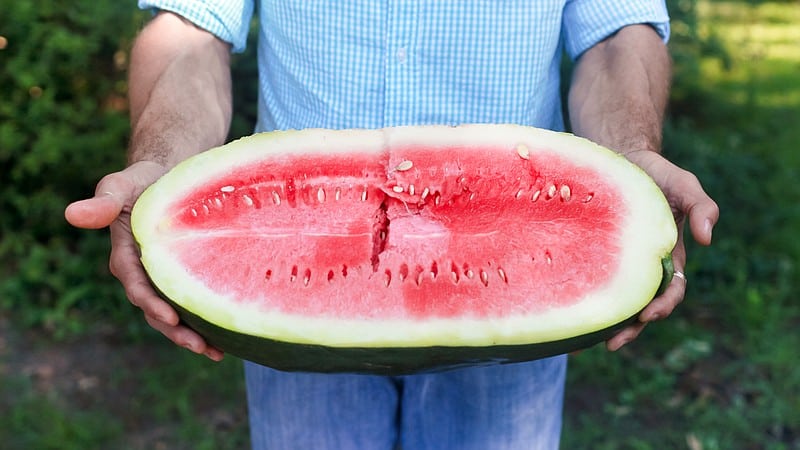 Vitamin C has a general strengthening effect on the walls of blood vessels, increases their density and elasticity, increases endurance and performance, improves the functioning of bone and connective tissue. A deficiency of the substance puts the immune and endocrine systems, heart, blood vessels, and digestive organs at risk.
Vitamin C has a general strengthening effect on the walls of blood vessels, increases their density and elasticity, increases endurance and performance, improves the functioning of bone and connective tissue. A deficiency of the substance puts the immune and endocrine systems, heart, blood vessels, and digestive organs at risk.
Watermelon is recommended for people who are watching their figure or want to lose weight. The presence of plant fiber in the composition enhances intestinal motility, normalizes bowel movements and stool consistency, and relieves constipation.
Reference. Fiber, like a sponge, cleanses the digestive tract of various types of toxins and waste, stimulates metabolism, and accelerates the process of fat breakdown. Once in the stomach, pectin fibers swell and take up free space, which is why the feeling of fullness is maintained for a long time, without the need for additional snacks.
Watermelon has a beneficial effect on vision, hair and nails, reduces muscle pain, inhibits inflammation in the body, increases urine flow without creating additional stress on the kidneys. Calcium in the composition is important for the formation and development of bone tissue, takes part in the mineralization of teeth, neuromuscular transmission, and blood clotting processes.Folic acids improve blood formation. Magnesium and potassium support the functioning of the nervous system. Silicon stimulates collagen synthesis.
Advice! You should not buy watermelon before August, since their ripening time is closer to autumn. Early products are often grown with the addition of nitrates; consumption of such watermelons is fraught with poisoning.
Chemical composition
Watermelon pulp consists of 92.6% water. The edible part of the fruit contains chemical components such as:
- pectin;
- easily digestible sugar (glucose, fructose, sucrose);
- starch;
- alkaline substances;
- vitamins: retinol, beta-carotene, thiamine, riboflavin, choline, pyridoxine, cobalamin;
- vitamin PP;
- ascorbic, pantothenic, folic acids;
- niacin;
- macroelements: chlorine, sulfur, phosphorus, calcium, potassium, magnesium, silicon, sodium;
- trace elements: boron, iron, vanadium, aluminum, iodine, lithium, cobalt, manganese, copper, rubidium, molybdenum, nickel, selenium, fluorine, strontium, zinc, chromium;
- essential and non-essential amino acids;
- saturated and polyunsaturated fatty acids.
KBZHU
Watermelon is classified as a low-calorie product: its energy value is 27 kcal per 100 g. The pulp contains practically no fat (0.1 g), but is saturated with carbohydrates (5.8 g). Protein content: 0.7 g.
Is it possible to eat watermelon with cholecystitis?
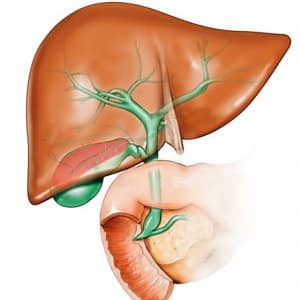 Experts' opinions on this matter are mixed. Obviously, in the acute period of the disease, watermelon, like other fruits and vegetables, is strictly contraindicated.
Experts' opinions on this matter are mixed. Obviously, in the acute period of the disease, watermelon, like other fruits and vegetables, is strictly contraindicated.
In other cases, the usefulness of the fetus depends on the causes of cholecystitis, general health, and the presence of concomitant diseases.
Points for and against
If the gallbladder is damaged, many foods are contraindicated, which is why the body may experience a deficiency of vitamins, micro- and macroelements that are important for the body.
The pulp of watermelon fruits partially reduces the need for ascorbic acid, retinol, magnesium, calcium, potassium, iron and other biologically active components.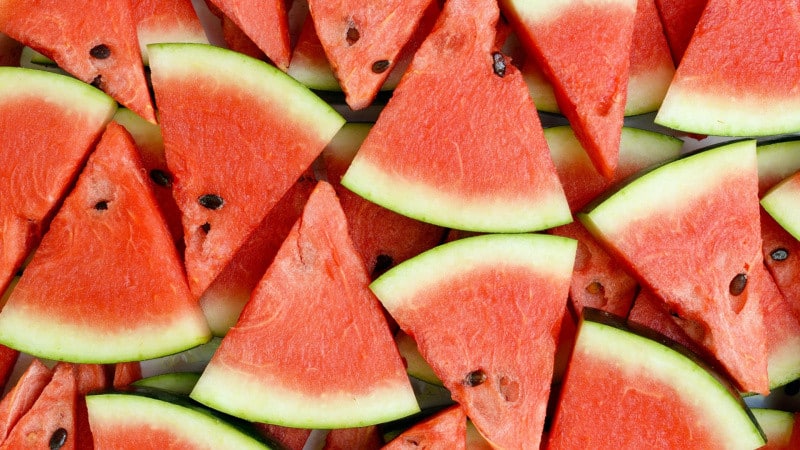 Watermelon in moderation acts as a diuretic: it increases the rate of urine formation, reduces the fluid content in tissues and cavities. At the same time, the fetus does not create additional stress on the kidneys, which helps to avoid the formation of salt stones in the organs of the urinary system.
Watermelon in moderation acts as a diuretic: it increases the rate of urine formation, reduces the fluid content in tissues and cavities. At the same time, the fetus does not create additional stress on the kidneys, which helps to avoid the formation of salt stones in the organs of the urinary system.
During the period of remission, watermelon is used as a natural choleretic agent. It enhances the formation of bile in the body and prevents its stagnation, activates the motor and secretory functions of the gastrointestinal tract, has a slight laxative effect and improves digestion processes in general.
The components in the sweet fruit have a beneficial effect on the condition and functionality of the digestive tract: they stimulate intestinal motility, normalize metabolic processes, and cleanse the intestines of waste and toxins.
The opinion that watermelon should be excluded from the diet of patients with cholecystitis is due to the presence in its composition of ascorbic, pantothenic and folic acids, which irritate the mucous membrane. Such exposure can cause an exacerbation of the disease and cause a new attack of pain.
Watermelon can harm the body if there are concomitant diseases of the gastrointestinal tract: for example, gastritis with high acidity. The edible part of the fruit is acidic, which leads to increased acidity in the stomach.High pH is accompanied by heartburn, belching, a feeling of discomfort and heaviness in the stomach, and may manifest as diarrhea or, conversely, constipation and bloating.
For reference. Increased stomach acidity is considered a provoking factor for peptic ulcers, chronic gastritis and duodenitis, and gastro-food reflux.
Rules for use for cholecystitis
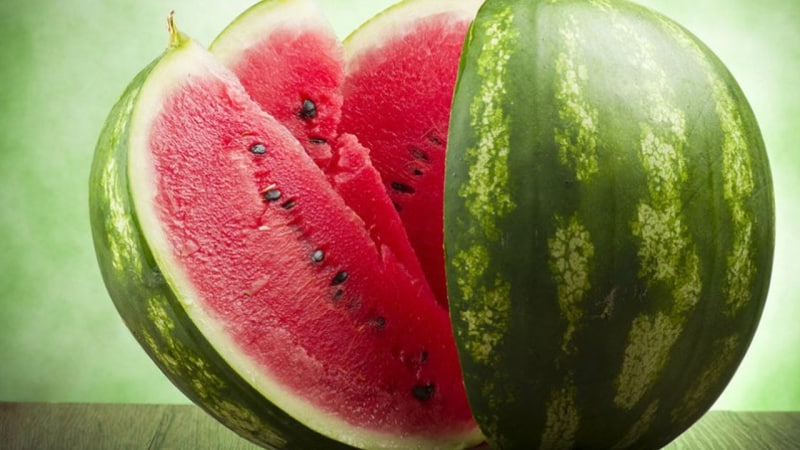
Let's start with how to choose the right watermelon. It is better to buy melons near the field where they grew, or at the market. Ideally, the fetus should weigh 6–10 kg. Larger berries can be grown with the addition of nitrates, while smaller ones have not yet had time to ripen.
There are general rules for consuming watermelon for cholecystitis:
- the fruit should not be eaten in the morning on an empty stomach, as the acids present in the composition have an irritating effect on the mucous membranes;
- introduce the fruit into the diet gradually, starting with one middle slice, subsequently increasing the norm;
- Do not drink it with water, milk, or other liquid, since watermelon already contains 92.6 g of water per 100 g of pulp;
- if general health deteriorates or a local allergy occurs, the product is excluded from the diet and the state of health is monitored;
- they buy melons only during their ripening in natural conditions: in the second half of August–mid-October;
- for diseases of the digestive system, it is not recommended to consume watermelon daily;
- after the pain subsides you can make juice from the sweet fruit: it is easier and faster absorbed in the stomach;
- in case of chronic cholecystitis, you can unload with watermelon once a week. During the day, consume 1.5 kg of pulp, dividing it into 5-6 doses;
- The optimal time for watermelon is a snack between main meals.
Most often the berries are consumed fresh. Used in the diet as an independent product or as an ingredient in fruit salads, canned. The edible part is processed into juice, which can then be evaporated to the consistency of honey.
Standards of use
Despite the usefulness of the fruit, it should not be consumed in large quantities. The average daily intake for an adult varies from 300 g to 1.5 kg (depending on the presence of other products in the diet, concomitant gastrointestinal diseases, contraindications). They eat no more than 200–300 g of pulp at a time.
Watermelon during exacerbation of cholecystitis
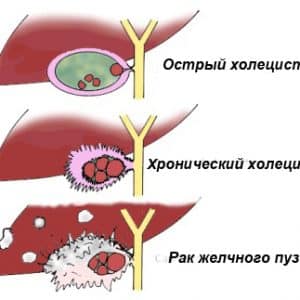 Watermelon, like other vegetables, fruits and berries, is strictly contraindicated for 7-10 days from the moment of the first symptom of the disease, until the pain is relieved, and during the period of exacerbation of the chronic form.
Watermelon, like other vegetables, fruits and berries, is strictly contraindicated for 7-10 days from the moment of the first symptom of the disease, until the pain is relieved, and during the period of exacerbation of the chronic form.
In the first days of inflammation, fasting is carried out to maximize the sparing of the mucous membrane. You can drink water, weak tea, rosehip decoction. On day 3, a strict diet is prescribed, excluding foods with chemical and mechanical irritation.
Patients are on this diet for 4-5 days. Next, grated porridge with water, soups, a little boiled meat, and white crackers are introduced into the diet.
As general health is restored and the functions of the pancreas are normalized, fresh vegetables and fruits, including watermelon, are allowed in limited quantities.
In chronic form
With chronic cholecystitis, you can eat watermelon in moderation, but only during remission. With regular and dosed consumption, the fruit helps restore the function of the biliary system and increase the rate of urine formation.
At the same time, gallstones are removed, the outflow of bile is normalized, the stagnation of which is of primary importance in the development of pathology.
Is it possible for pancreatitis?
Since diseases have similar causes and symptoms, nutrition also has a lot in common. For patients in the acute period of pancreatitis, any food is contraindicated. After the pain has subsided and the general state of health has stabilized, it is allowed to include the edible part of watermelon in the diet in moderation.
Contraindications
The fruit is strictly contraindicated in case of individual intolerance to the component(s) of the composition.
Relative contraindications include:
- gastritis with high acidity;
- peptic ulcer of the stomach and duodenum during the period of exacerbation;
- the presence of large salt stones in the urinary system.
Precautionary measures
Watermelon, like other vegetables and fruits, must be consumed in season during their ripening period in nature. It is important to pay attention to the pulp: purple color is a sure indication of the presence of nitrates. The healthy pulp will be sugary and grainy, without yellow streaks. If it is smooth and even, such a watermelon cannot be eaten. A high-quality fruit has a tail that is not overdried, but not green either; there is a small yellow spot on the side.
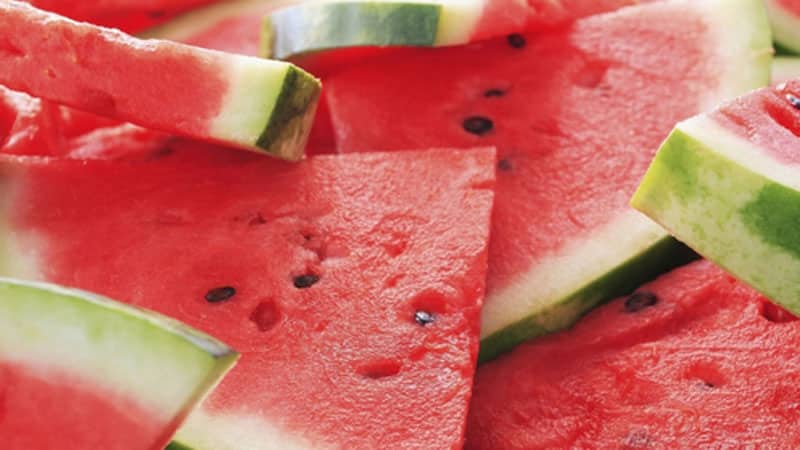 In cases where, after eating watermelon, the general state of health has deteriorated, local signs of allergy appear in the form of redness, rashes and peeling on the skin, new attacks of pain, the fruit should be abandoned for a while. If after this the condition has not stabilized, medical attention is necessary.
In cases where, after eating watermelon, the general state of health has deteriorated, local signs of allergy appear in the form of redness, rashes and peeling on the skin, new attacks of pain, the fruit should be abandoned for a while. If after this the condition has not stabilized, medical attention is necessary.
Read also:
Do picked watermelons ripen at home?
Step-by-step instructions: how to dry watermelon in an electric dryer.
Conclusion
Diet for pancreatitis and cholecystitis plays an important role in all periods of the disease.Watermelon is included in the list of permitted products, but its pulp is consumed in moderation and only during exacerbations. During the period of remission, high-quality melons, like other fruits and vegetables, will be beneficial to health.
The unique properties of watermelon help relieve swelling, promote the removal of excess fluid and salt stones, normalize metabolic processes, reduce bile stagnation, activate the gastrointestinal tract and cleanse the body of waste and toxins. To be sure of benefit product in the case of a particular patient, it is necessary to exclude possible contraindications and consult a doctor.